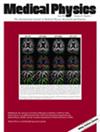Postal dosimetry audit for scanning proton beam using radiophotoluminescence glass dosimeter: A multicenter pilot study
Abstract
Background
Accurate dosimetry is important in radiotherapy, and all equipment used for radiotherapy shoud be audited by an independent external dose audit. Radiophotoluminescence glass dosimeter (RPLD) has excellent characteristics and is widely used for postal dose audit; however, postal dose audit for proton therapy using RPLD has not been established.
Purpose
This study aims to develop a postal dose audit procedure for scanning proton beams using RPLD, estimate uncertainties, and conduct a multicenter pilot study to validate the methodology.
Methods
A postal toolkit was developed and a postal dose audit procedure for RPLD measurements of scanning proton beams was established in cooperation with several facilities that employ various accelerators, irradiation equipment, and treatment planning systems (TPS) for clinical use. Based on basic and previous studies, an uncertainty budget was developed for estimating relative uncertainty and pilot studies were conducted at each site. A method for postal dose audits was developed in a multicenter collaboration to develop an approach suitable for implementation across multiple facilities.
Results
The relative response of 60 RPLDs for scanning proton beam examined in this study was 1.00 ± 1.28% mean ± standard deviation. The combined relative standard uncertainty of postal dosimetry for scanning proton beams using the RPLD was 2.97% (k = 1). Under the reference condition, the maximum differences between the ionization chamber measurement (IC) and TPS, RPLD and TPS, and RPLD and IC were 0.97, 1.88, and 2.12%, respectively. The maximum differences between the RPLD and ionization chamber for plateau measurements at 3 cm depth using single-energy and non-reference conditions were 11.31 and 4.02%, respectively.
Conclusion
We established a procedure for the postal dose audits of proton beams using RPLD and presented the results of a multicenter pilot study. By standardizing the reference conditions, the dosimetry uncertainty was estimated at 2.92%. The results demonstrated the feasibility of performing an independent third-party dose audit of scanning proton beams using RPLD, and for such postal dose audits for proton beams, the irradiation conditions should be standardized to reduce uncertainties. These results are expected to contribute to the development of proton beams.

 求助内容:
求助内容: 应助结果提醒方式:
应助结果提醒方式:


